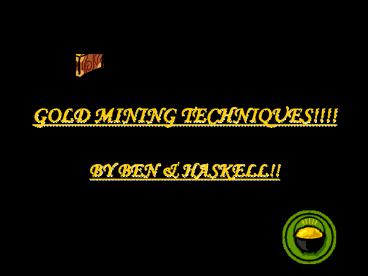GOLD MINING TECHNIQUES - PowerPoint PPT Presentation
1 / 12
Title:
GOLD MINING TECHNIQUES
Description:
The cradle was one of the most successful mining method of the gold ... There were many clues to finding gold such as galena, lead sulphide, mundie and sulphur. ... – PowerPoint PPT presentation
Number of Views:386
Avg rating:3.0/5.0
Title: GOLD MINING TECHNIQUES
1
GOLD MINING TECHNIQUES!!!!
- BY BEN HASKELL!!
2
SMALL SCALE MINING!!
3
The Cradle
- The cradle was one of the most successful mining
method of the gold rush period. The cradle
looked like two boxes, one on top of the other.
Inside the boxes were slats to regulate the water
flow. On top was a sieve to remove big rocks and
on the bottom of the cradle were slats to catch
the gold. Water was poured through the cradle to
make this effect. The rubbish came out the end.
The cradle was rocked to swill the water and the
dirt.
4
Teamwork
- Many miners worked in teams to maximise the
amount of gold they found. These team mates were
usually business partners or friends. They split
the licence fee amongst themselves and shared all
the gold they found. These teams from two to up
to 10 would mine shafts and would rely on each
other to take care of sick or wounded miners.
5
Shaft Mining
- The shaft mine was a small mine dug vertically in
to the ground by teams of miners. These mines
were shallow as the miners didnt have the time
nor the equipment nor the money to dig the deep
holes that the big companies mined. It would not
have been worth the miners while digging so deep
to reach the extensive quartz veins below the
surface. Another reason they were small was
because they mined meticulously to extract any
gold in the mine and as soon as the flow of gold
wavered, they would leave.
6
Large Scale Mining
7
Reef Mining
- The reef mine was introduced after the initial
gold rush when alluvial gold became harder to
find. Rich men funded big machines to dig down
to the extensive gold-bearing quartz veins and
paid the miners wages. This was very attractive
for the miners because it was becoming too
expensive to continue mining shafts and that they
would get paid to mine gold. Some miners said
that it took the splendour out of gold mining
because all the gold found went to the boss.
8
The Stamper
- The stamper was a big machine that could extract
ore from rocks by crushing it. Both the stamper
and the engine were expensive and could only be
purchased by very rich people. The stamper was
a series of heavy weights attached to cam shafts.
The stamper was powered by engines or they were
powered by the water wheel. The cam shafts were
pulled up and then dropped on the ore crushing it
to a fine powder. The powder was then washed
with Mercury which was then evaporated leaving
the gold behind. The stamper was usually used in
conjunction with the reef mine because of its
efficiency.
9
Deep Sinking
- Many rich men funded mines very deep down because
of the gold-bearing quartz veins. These were
different to the reef mines because reef mines
didnt go down as far as the deep sink mines.
Deep sink mines were very expensive because very
often they would have to drill through a big
layer of rock without finding any gold. Because
of this, the employer of the miners would be in
debt. There were many upsides to deep sink
mining, however. Deep down were numerous large
veins in which there was much more gold than reef
mines. There were many clues to finding gold
such as galena, lead sulphide, mundie and
sulphur.
10
The Gold Factory
- The gold factory was a gold processing plant that
would process gold ore with a series of stampers.
The mining companies would pay the gold factory
money for crushing the ore and the factory would
then give back the crushed gold. If you owned
one of these companies, it would be like a
licence to print money as these companies made
lots of business.
11
The Water Wheel
- The water wheel was not actually a mining
technique, it was a power source for some of the
mining techniques. It could provide the power
for the gold factory or it could provide light
for the mines. The water wheel was a big
apparatus that had numerous buckets. Because the
water wheel needed flowing water to function, the
water wheel was positioned over a strong river.
As the buckets collected water, the weight tuned
cogs in turn turning turbines making electricity.
12
Credits
- www.westcoast.org.nz/Slot_IN_files/IN0007.html
- www.museum.victoria.au/windows/gold/model.asp
- www.oldmogotown.com.au/stamper.html
- www2.nature.nps.gov/geology/aml/
- www.scienceviews.com/photo/browse/SIA0608.jpg
- www.homepage.eircom.net/rcag/history/dublin.html
- www.langintro.com/seoul /museum0.htm































